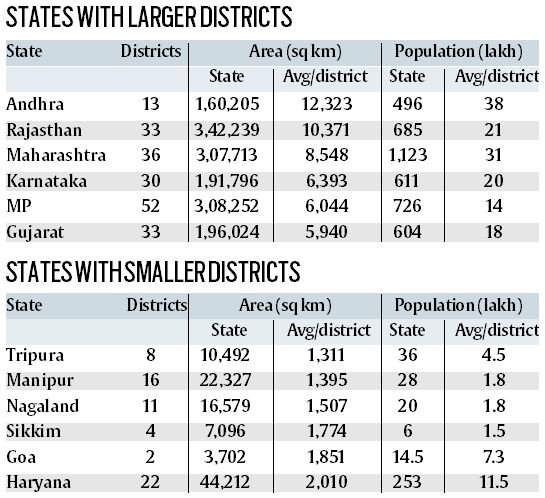Context
- Tamil Nadu Chief Minister Edappadi K Palaniswami announced that Vellore district would be trifurcated to create two more districts, Ranipet and Tirupattur. In January and July this year, the Tamil Nadu government had created three new districts, and the latest move will take the total number of districts to 37. The idea behind creating new districts in any state is, generally, that it is expected to make governance easier; sometimes, the decision is driven by local demands.
Facts & Figures
- The larger states predicatbly have a higher number of districts, with Uttar Pradesh (75) leading the count, followed by Madhya Pradesh (52), while the smallest state, Goa (2), has the lowest number. However, the number of districts in a state is not always a function of the area of the state, or of its population.
- For example, Andhra Pradesh is the seventh largest state by area but has among the smallest counts of districts at 13. As such, it has only one district for every 12,000 sq km, which is the largest average size for a district in any Indian state.
- At the other end of the scale is Tripura. Being a small state, it has only eight districts, but even that is high, when compared to any other states, in terms of the number of districts per unit area.
- Tripura has one district for every 1,300 sq km, the smallest average district size in the country. It means an average Andhra Pradesh district is more than nine times the size of an average Tripura district.
- An Andhra Pradesh district has an average population of 38 lakh while a Tripura district has only 4.5 lakh.
- Most of the Northeastern states have smaller districts — which means a higher number of districts per unit area.

- Tamil Nadu’s 37 districts will be the fourth highest count in the country, just behind Bihar’s 38. The average size of a Tamil Nadu district will now be around 3,500 sq km, down from 4,000 sq km before January.
- Behind UP, MP, Bihar and Tamil Nadu, the highest district counts are 36 in Maharashtra (average 8,547 sq km); 33 each in Assam (average 2,377 sq km), Rajasthan (10,371 sq km) and Gujarat (5,940 sq km); 31 in Telangana (3,615 sq km); and 30 each in Karnataka (6,393 sq km) and Odisha (5,190 sq km).
Source:IE
